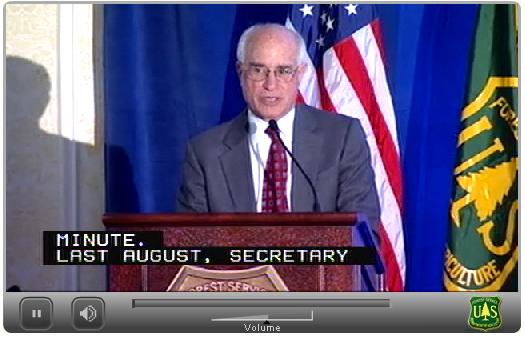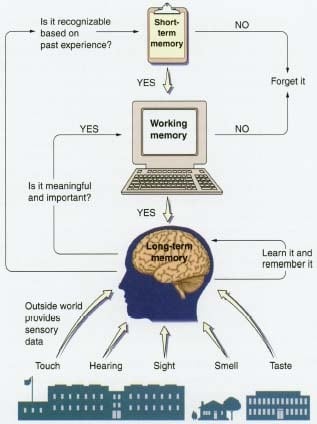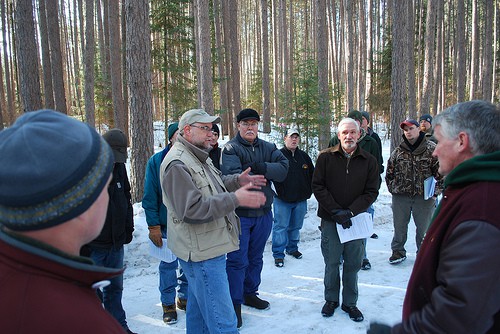
The first panel of today’s science forum emphasized landscape scale planning across multiple ownerships.
Tom Sisk  from Northern Arizona University began with the word: “practical”. (slides pdf) The next 20 years of the science about landscape scale management will focus on transparency, inclusion, and public deliberation. We are learning to “scale up” our management because of our experience with uncharacteristic large fires and changes in fire regimes. Sisk showed a map of the large footprint of the Rodeo-Chediski fire in state of Arizona. The fire spread until it ran out of forest. Also, wide-ranging species operate at landscape scales, especially when land uses have the potential to fragment habitat. The protection of diversity will require a continued focus on viability, but with advances in monitoring and assessment, we can estimate species distribution by presence/absence data (which was done for goshawks on over 2 million acres in Northern Arizona). Finally, exotic species are changing the ecosystem dynamics across the continent. Sisk pointed out the predicted occurrence of cheatgrass using preliminary maps of areas most vulnerable to invasion. He added that the covariates driving these models involve climate, which are useful in predicting effects of climate change.
from Northern Arizona University began with the word: “practical”. (slides pdf) The next 20 years of the science about landscape scale management will focus on transparency, inclusion, and public deliberation. We are learning to “scale up” our management because of our experience with uncharacteristic large fires and changes in fire regimes. Sisk showed a map of the large footprint of the Rodeo-Chediski fire in state of Arizona. The fire spread until it ran out of forest. Also, wide-ranging species operate at landscape scales, especially when land uses have the potential to fragment habitat. The protection of diversity will require a continued focus on viability, but with advances in monitoring and assessment, we can estimate species distribution by presence/absence data (which was done for goshawks on over 2 million acres in Northern Arizona). Finally, exotic species are changing the ecosystem dynamics across the continent. Sisk pointed out the predicted occurrence of cheatgrass using preliminary maps of areas most vulnerable to invasion. He added that the covariates driving these models involve climate, which are useful in predicting effects of climate change.
Later during the panel discussion period, Visk said that an agreement in Northern Arizona brought people together. Those efforts filtered into a state-based process. The State office took the next steps, which led to a statewide strategy. Visk said that different people who participated in the overall process had different levers they could use to shape the decisions. He added that there was a pulling of people together through the various jurisdictions. For scientists, these processes can be a challenge since they provide the analytical framework, matching analysis to questions. He said that data in Landfire and other programs help provide capacity.
Sisk also pointed out the collaborative work being done on 3 million acres in northern New Mexico. He said that one way to address the historic controversies is to empower people with information. This new science can reside in everybody’s minds. Land ownership can fragment our thinking rather than looking at integrated landscape properties. Sisk described working with 50 people in breakout groups to identify priority areas for management attention, and recommending types of management in those priority areas. Next, they looked at the predicted effects and what the landscape would look like.
Sisk said that science must be transparent, but not dumbed down. It must be rigorous, repeatable, and defensible so that is will inspire confident action. The public must own the science if they are to trust and accept decisions based on it. The planning process should provide a predictive capacity and allow exploration of alternative scenarios. Scientists should inform and not attempt to dictate decisions. He said that landscape ecology is a mature field, but it will require a bold attempt to embrace multiple scales.
Jim Vose  from the Forest Service Southern Research Station talked about watershed science. (slides pdf) Much of what is known is at small scales, because watersheds are so complex. The challenge becomes taking the small scale knowledge and moving it to the watershed and landscape scale. He added that watersheds don’t operate in isolation – they are connected. He said that disturbances and habitats go beyond watersheds. Movement of materials is the primary ways that watersheds interact, and hydrologic flowpaths are the primary way that small watersheds interact with larger watersheds.
from the Forest Service Southern Research Station talked about watershed science. (slides pdf) Much of what is known is at small scales, because watersheds are so complex. The challenge becomes taking the small scale knowledge and moving it to the watershed and landscape scale. He added that watersheds don’t operate in isolation – they are connected. He said that disturbances and habitats go beyond watersheds. Movement of materials is the primary ways that watersheds interact, and hydrologic flowpaths are the primary way that small watersheds interact with larger watersheds.
Water is an excellent integrator of watershed health: the cleanest water comes off certain landscape types. As water flows through land uses, water quality declines. Landscape design and configuration has a big effect on water quality. Any type of land management alters water processes and impacts resilience. Most best management practices (BMPs) deal with the physical aspects of land disturbance.
Vose described innovations in linking “bottom-up” (streamflow gauging) and “top-down” (satellite imagery) technology. There is more data from the last 20 years than the previous 80 years. There is a variety of sensing technology, which can be used to develop monitoring networks. Networks can go to satellites, to monitor what’s going on with landscapes. We can quantify watershed processes, as data comes together from the bottom to the top, all the way to landscapes. We can address the relationship of large scale carbon and water cycling. Vose also mentioned the importance of large networks of experimental forests and the new megamonitoring network of the National Ecological Observatory Network (NEON). Regarding climate change, Vose mentioned that we can look at long-term data in new ways.
Vose said that we need to focus on the Where? How? What? and Why? for restoration. The “where” is really important (it’s not random acts of restoration). We need to look at high risk areas and “avoid the unmanageable and manage the unavoidable.”Finally, the really big challenge is the “how” – looking across ownerships need partnerships and approaches; and recognition of connectivity.
Connie Millar from the Forest Service Pacific Southwest Station said that we need to confront all the dimensions of climate change, not just greenhouse gases. (slides pdf) We need to understand that climate is a driver of change. Climate often changes in cycles, nested at different scales from annual changes to millenial changes. Different physical mechanisms drive changes at different cycles, like an orchestra where the music is the combined forces of instruments: individual cycles, gradual or directional, extreme or abrupt. However, species and ecosystem respond to the orchestra with “a cacophony of responses.”
from the Forest Service Pacific Southwest Station said that we need to confront all the dimensions of climate change, not just greenhouse gases. (slides pdf) We need to understand that climate is a driver of change. Climate often changes in cycles, nested at different scales from annual changes to millenial changes. Different physical mechanisms drive changes at different cycles, like an orchestra where the music is the combined forces of instruments: individual cycles, gradual or directional, extreme or abrupt. However, species and ecosystem respond to the orchestra with “a cacophony of responses.”
Forests we manage are still responding to the long term cycles of history that they have encountered. That makes a difference in how we can address climate in the future. For instance, when looking at glacial-interglacial cycles, we have evidence of over 40 cycles of greenhouse gas levels. Over time, species have moved up and down in elevation to respond to climate (north and south in the east). There are enduring changes in genetic diversity which we’re still seeing today. There have been a number of ecosystem “flip flops”: some transitions had rapid change, analogous to what we have now. Some warming has occurred in less than 75 years, with replacement of whole forest types.
We’ve had cycles of 1000 year periods due to changes in solar activity – we’ve just come out of a cold phase. A little ice age ended in 1920. Before that, there was a medieval anomaly with some warming and century long droughts. Tall fast growing trees are now above tree line due to a change over 650 years, the lifespan of a single tree. Their size and survival now depend upon their area of origination not where they currently reside.
Millar says that the shortest scale changes are the decadal or the annual scale changes. The 20-50 year cycles affect parts of world differently – internal ocean circulation and ocean temperature. The shortest is the El Nino/ LaNina 2-8 yr cycle. She said that anthropogenic forcing is important at these shorter time scales. We could see type conversions, invasions into barren lands, massive forest dying, higher elevation mortality as insects move upslope, and fires occurring in winter. There are also important aspects of climate change at local scales, either natural forces or greenhouse gases. Millar showed examples of the ice cover in the Great Lakes affecting shipping, and how 70% of wildfires in the West are La Nina events during decadal cycles. For local management at small scales, the local climate responses can be decoupled from effects at a regional scales. For instance the American pika (the temperate polar bear) can escape the warm heat by the air conditioned ground.
Millar said that climate is a fundamental architect of ecosystem change in all its flux and dynamics. The historical conditions are increasingly poor reference and we need to look forward. Also, human land use cover creates new challenges.
Later during the panel discussion period, Millar said that the planning rule should address climate as a macro-disturbance process. The rule should provide for adaptive capacity of species (species ranges and species diversity) by understanding climate’s role.
Millar also answered a follow-up question from the audience about definitions. She advised the use of definitions specifically. The term “resistence” describes the ways to armor species in the short run against climate effects. The term “resilience” is the most widely interpreted term, from the meaning used in the field of engineering, to the idea of returning something to its previous state. It can be thought of as the capacity of a system to absorb change without changing its state. Millar said that resistence and resilience are mid-term strategies. Meanwhile, “restoration” can be a range of options from small scale to large scale. It will be important to define what we mean.
Max Moritz  from UC Berkeley concluded the first panel with a discussion of fire ecology. (slides pdf) He said that the conventional wisdom is that climate change has resulted in increased fire activity because of warmer spring temperatures and earlier snowmelt. But for shrublands, we haven’t seen the same effects. Fire regimes respond to changes to multiple climate variables (temperature, precipitation quantity, and timing).
from UC Berkeley concluded the first panel with a discussion of fire ecology. (slides pdf) He said that the conventional wisdom is that climate change has resulted in increased fire activity because of warmer spring temperatures and earlier snowmelt. But for shrublands, we haven’t seen the same effects. Fire regimes respond to changes to multiple climate variables (temperature, precipitation quantity, and timing).
We’ve been worried about the problem of fire exclusion. But scales of climate change and fire are quite broad. Fires cross administrative boundaries, and different ecosystems may be adapted to very different fire regimes.
We also only think about one kind of fire, a low severity fire. Yet a lot of ecosystems have different fire sensitivities even to these types of fire.
Moritz said he liked the ecosystem service framework, which can give us common terms and currencies. For fire, we need some common definition and understanding of both beneficial and detrimental roles. Healthy? Resilience? A lot of the definitions and a lot of the goals can actually contradict each other.
Mortitz described a case study of range shifts to show the benefits and detriments of fire. The rate and intensity of climate change is important to the plasticity and dispersal ability of species. Many species will have to move 1 km per year to keep up with their suitable climate envelope. There is a huge extinction potential. Moritz also mentioned that many habitat models are missing the effects of fire. He said that we might see large scale invasions and retreats of fire. As far as species movement, fire can hasten the movement of “trailing edge” losses and benefits of habitat change.
Regarding how fire releases carbon, he said we tend to emphasize stocks, instead of fluxes. Ecosystems have a carrying capacity – forests will regain a standing carbon stock. Fire is a temporary blip – but if you factor in regrowth it’s not quite as drastic. Black carbon or “biochar” charcoal is a relative stable form of carbon – with every fire the carbon is fixed relative permanently.
Moritz said that the ongoing fragmentation of land ownership is a problem, especially when landowners have a decreasing interest in ecosystems and the resources needed to reduce fire related consequences.
Finally, Moritz said that there is lots of uncertainties. Fire regimes are fuzzy concepts to begin with. There is often almost no knowledge of some areas: for instance we have very little info on wind patterns. However, the broad scope of the planning rule is a plus.
Discussion
After the presentations, there was a panel discussion and question and answer period. The discussion centered on the topics of uncertainty, scale of analysis, integration of science with local knowledge, and the value of historical data in light of climate change.
Uncertainty
Sisk observed that uncertainty is one of the two or three key pieces of landscape planning. Scientists try to reduce uncertainty, which is a foreign concept to nonscientists. A scientist must take responsibility for being clear about that. People aren’t ready to receive uncertainty – they are ready to receive the data, but combining data sources each with its own level of uncertainty will blow up the whole process. Vose added that there is a tremendous amount of pressure on scientists to tie practice and science in an uncertain way. Sisk observed that scientists can relate to a scenario based exploration with a sensitivity component.
Sisk emphasized that adaptive management and management flexibility aren’t the same. Adaptive management is a structured process where you collect monitoring data and feed it into a learning structure established in the plan a priori. The results of data collection constrain the decision space. So adaptive management is less flexible.
There was a followup question from the audience about the uncertainty of science. Sisk said that the literature has shown for a long time that technical experts can be wrong. He added that science informs the citizens and leaders in a democracy. How to interpret uncertainty is best left to deliberation in a democratic society. Millar added that having panels when there are known differences in the science is important. It’s important to display the differences in a transparent process.
One audience participant expressed frustration at Forest Service project NEPA documents that fail to address climate change because the issue is uncertain. Millar said that there always is insufficient knowledge, so that is a cop out. When addressing climate change we need to think about nesting a local analysis within larger spatial scales, and work with the knowledge we have. Vose said that some body of information can be synthesized.
Sisk said that when we lack information we still need to make tough decisions. Sisk said that the “Precautionary Principle” has been used in Europe and mentioned in the Rio conference. In order to protect the environment, management should be appled according to the ecosystem capabilities. Sisk said that a lack of uncertainty should not be used to adopt environmental protections. Later, there was a follow-up question from the audience about whether we should be using adaptive management instead of the Precautionary Principle. Sisk reminded everyone that the Precautionary Principle cuts both ways: both taking and not taking action. We should not let uncertainty stop us in our tracks.
Regarding adaptive management, Vose gave examples of testing that was done, and talked about the importance of the network of experimental forests. He said we should go slow, but test, monitor, and adapt. He said that models are becoming increasingly sophisticated for making projected assessments. Moritz said that in the absence of knowledge, if we can identify thresholds that we can seek and test for, we can provide some boundaries.
Scale of Analysis
At the beginning of the discussion period, Sisk noted that one thread throughout all of the talks was the need to be able to work at different scales to do intelligent planning. Vose said that the scale of operation is the larger scale. Sisk said that for the West, THE issue is water and the future of water resources. Water influences the level of organization and how we scale planning. John Wesley Powell had this figured out. In some areas watersheds make sense, other areas they don’t, as an organizing tool. Millar added that we should also crosswalk our analysis with nested temporal scales. Moritz added that although “firesheds” is a term that is not well defined, it brings up this idea of nested scales. But we first need a common language and common definitions.
There was a question from the audience about NFMA planning at a forest scale. Vose said that watersheds are all relative, and you need to look at all scales of watersheds in planning, but a common focus is the 8th level HUC. The real challenge is when you mix National Forest System and private land with different land uses, with no jurisdiction or a means to work in a coordinated way.
Integrating Science with Other Sources of Knowledge
One audience participant was concerned about science being compromised in local collaborative processes. The question is “how can the public own the science while keeping science sound?” Sisk said that science has a high social relevance, and science efforts are supported by society. Traning is important. Scientists have a responsibility to get their information back into social side of decisionmaking. We need to make a concerted effort to improve the integrity of the knowledge. It’s the responsibility of the scientists to participate in the discussions to talk about the valid use of their science. In local collaborative processes, when conducted in a respectful and inclusive manner, there is a receptivity to science. This isn’t the case when decisions “based on science” are laid out for people. Sisk mentioned the idea of “braiding” of knowledge, referring of an example of Hopi collaboration. It’s not watering down the knowledge, but braiding the knowledge together, which is stronger. Sisk said this is the most promising vision to address these huge challenges. Millar added that there is a long history of observation among tribes.
Moritz said that most scientists working at the landscape scale are not as much reductionists as other scientists. At this scale, the problems are all connected. Vose added that the most successes are when landscape and smaller scales come together. The NEON program is an attempt to bridge that gap.
There was a later followup question from the audience about communcations with the public. Moritz said that you can’t expect the public to dig through the journals, but the public has to have some level of literacy. It has to go back and forth. Millar talked about the role of a “boundary spanner”, someone that can communicate from the formal science to the applied world. We might not have answers at the scale of the operational level. Sisk added that a collaborative process can bridge communication. Of course some collaborative processes are imperfect, but communications in collaboration processes are not engineered but take place more organically. Mortiz added that sometimes science is out there, and there is a responsibility for scientific literacy.
Role of the Historic Range of Variability (HRV) Assessment Given Climate Change
There was a question from the audience on the reliance of an HRV assessment in a landscape analysis when climate change may be creating conditions not previously experienced. Millar said that we can still be informed by an historic process. The HRV concept is still important but we need a different pair of glasses. We need a realignment while using knowledge from the past about where we’ve been, looking at different earlier patterns that are more similar to where we are going.
Moritz said we need to be educated by HRV, but not be blinded by it. There are two pieces of info: where we came from and where we are going.
Climate Change Strategies
Moritz said that the idea of assisted migration of species is relatively new and scary. After a fire, if a species has taken a big hit, assisted migration might be a tool. Millar said that extreme events historically have major changes in ecological trajectories. Large scale disturbance are opportunities for quickly catching up. We can enable succession rather than force it. Systems can reequilibrate or catch up. Sisk said that our first line of defense should be to maintain connectivity so that organisms can move on their own. Some animals and long lived plants can do that better than we can think. Regarding extreme events, Vose said that we can understand hydrologic responses to extreme events. There are tools and models available.

















